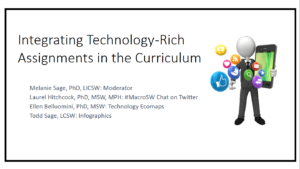Day Two of #SWDE2017 – Integrating Technology-rich Assignments in the Curriculum
 From April 12-14, 2017, the third annual Social Work Distance Education Conference was sponsored by Our Lady of the Lake University’s Worden School of Social Service in San Antonio, TX.
From April 12-14, 2017, the third annual Social Work Distance Education Conference was sponsored by Our Lady of the Lake University’s Worden School of Social Service in San Antonio, TX.
Melanie Sage & Todd Sage of the University of North Dakota, Ellen Belluomini of Dominican University, and I participated in a panel discussion about incorporating technology-based assignments in the social social work curriculum. We talked about three different types of technology-based assignments that can be incorporated into almost any classroom: Twitter Chats, Technology Assessments, and Infographics.
You can access a copy of the slides here: https://www.slideshare.net/laurelhitchcock/integrating-technologyrich-assignments-in-the-curriculum. We also have some assignment specific resources:
Twitter Chats (Laurel Hitchcock):
– MacroSW.com: https://macrosw.com/
– Hitchcock, L. (2016, March 14). Using #MacroSW in the Classroom. Retrieved from https://laureliversonhitchcock.org/2016/03/14/using-macrosw-in-the-classroom/
Technology Assessments (Ellen Belluomini):
– Belluomini’s Blog – Bridging the Digital Divide in Social Work Practice https://socialworksdigitaldivide.blogspot.com/
– Family Technology Evaluation: https://www.academia.edu/32103932/Update_Technology_Evaluation_Family_3_17
Infographics (Todd Sage):
– Jones, N. P. (2017, February 24). Teaching with Infographics: My experiences with digital literacy and non-traditional students. Retrieved from https://laureliversonhitchcock.org/2017/02/24/jones_infographics/
– Hitchcock, L. I., Jones, N. P., Sage, M. (2017). #BPDNOLA17 – Visualizing Data: Infographic Assignments across the Social Work Curriculum. Retrieved from https://laureliversonhitchcock.org/2017/02/24/bpdnola17infographics/
Here is our abstract with the learning objectives:
By the end of the session, participants will be able to:
1. Understand ways to socialize social work students to perform in the role of the practitioner
2. Understand ways to harness technology to involve students in social work practice beyond their communities
3. Involve students in creating versus just completing assignments.
In this panel, four educators describe why and how they incorporate social media in classes across the curriculum. Ethical practice, professional presentation, grading social media assignments, preparing students to present for a public audience, and FERPA issues will be addressed.
A perennial struggle for social work educators is balancing theory with practice. In the best social work programs, classroom learning provides a theoretical framework for the situations students will face in field, and field experiences enable students to develop competency translating theory into practice skills. In the worst situations, there is little to no connection between the academic study of social work and what students are expected to do in the field. Although some educators will argue that social work’s “signature pedagogy,” field education, is tasked with ensuring students “integrate theory and practice” (Council on Social Work Education [CSWE], 2008, p. 8), field education alone is insufficient to ensure students have the practice skills necessary to be competent social workers (Bogo, Rawlings, Katz & Logie, 2014). According to the theory of experiential learning (Kolb, 1984), ideal learning happens in contexts that offer concrete experiences and active experimentation alongside abstract and reflective learning. Bloom’s Taxonomy (1994) suggests that higher-order thinking skills include creating, designing, and producing information, whereas classroom assignments often reinforce lower-level thinking such as interpreting, explaining, and comparing. Situations in which students can develop and execute products with real world application, reflect on the relationship between theory and practice, and receive specific feedback about their efforts is an ideal learning context. Information and Communication Technologies can serve as a bridge between the classroom and field. Interactive technologies such as Twitter, blogging, podcasting and other interactive media tools make it possible for students to develop academic assignments that will be treated as both classroom artifact as well as public content. The prospect of public consumption forces students to consider their audience, the skills they need to engage in making a quality product, and the impact of their work well beyond the professor and classroom. Inviting the outside into the classroom also provides an invaluable opportunity to engage with the practice community and receive feedback from multiple sources. By engaging agency leaders, community members, and other constituents, students gain an authentic experience which can bridge the classroom – field setting divide. For example, social work educators have brought classroom discussions of policy and practice into the public domain through the use of Twitter (Hitchcock & Batista, 2013). Although some tech-savvy social work educators are already using technology to bridge the gap, many educators lack the time and energy to develop new assignments. The purpose of this panel is to present technology-mediated assignments that social work educators can use to allow students to practice while still in the classroom. The assignments are structured so that students demonstrate competency, professional ethics, and clear transfer-of-learning for the real world while under the supervision of their instructors. In this workshop, four educators will describe how they have integrated technology-rich social media assignments across the curriculum and address common concerns.
References:
Bogo, M., Rawlings, M., Katz, E., & Logie, C. (2014). Using Simulation in Assessment and Teaching: OSCE Adapted for Social Work (Objective Structured Clinical Examination).CSWE: Alexandria, VI
Council on Social Work Education. (2008). 2008 Educational Policy and Accreditation Standards for Baccalaureate and Master’s Social Work Programs. Alexandria, VA: Council on Social Work Education. Retrieved from https://www.cswe.org/getattachment/Accreditation/Standards-and-Policies/2008-EPAS/2008EDUCATIONALPOLICYANDACCREDITATIONSTANDARDS(EPAS)-08-24-2012.pdf.aspx
Hitchcock, L. I., & Battista, A. (2013). Social Media for Professional Practice: Integrating Twitter With Social Work Pedagogy. Journal of Baccalaureate Social Work, 18(Supplement 1), 33–45. https://doi.org/10.5555/basw.18.suppl-1.3751j3g390xx3g56
Kolb, D. A. (1984). Experiential learning: Experience as the source of learning and development. Upper Saddle River, New Jersey: Prentice Hall.
How to Cite the Blog Post:
Sage, M., Belluomini, E., Hitchcock, L., & Sage, T. (2017, April 13). Day Two of #SWDE2017 – Integrating Technology-rich Assignments in the Curriculum. Retrieved from https://laureliversonhitchcock.org/2017/04/13/day-two-of-swde2017-integrating-technology-rich-assignments-in-the-curriculum/


